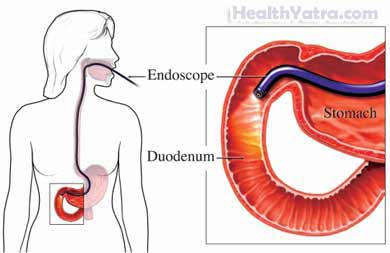Definition
Esophageal varices are abnormal blood vessels that develop in the esophagus. They have abnormally thin walls and the blood pressure within them is very high. This combination makes esophageal varices dangerous, because they can burst and cause life-threatening bleeding.
Esophageal variceal injection is a procedure to either prevent future bleeding or stop active bleeding. During the procedure, medicine is injected into or alongside esophageal varices. When injecting into the vein, the medicine causes blood clots to form, blocking the vein from bleeding. When injected alongside the vein, the swelling in the area compresses the vein, preventing it from bleeding.
The procedure is also known as sclerotherapy.
Reasons for Procedure
Esophageal varices can be life-threatening. Esophageal variceal injection is a procedure that can make them less likely to bleed. The procedure is also used to stop active bleeding from esophageal varices.
Possible Complications
Complications are rare, but no procedure is completely free of risk. If you are planning to have an injection, your doctor will review a list of possible complications which may include:
- Painful swallowing
- Esophageal narrowing
- Bleeding
- Esophageal damage
- Infection
Some factors that may increase the risk of complications include:
- Alcoholism
- Bleeding disorder
- Active bleeding
- Increased age
- Heart or lung problems
What to Expect
Prior to Procedure
- Do not eat for 8 to 12 hours before the procedure.
- If you have diabetes, discuss your medicines with your doctor.
- Arrange for transportation after the procedure. You should not drive for 24 hours after the procedure.
- Talk to your doctor about your medicines. You may be asked to stop taking some medicines up to one week before the procedure, like:
- Aspirin or other anti-inflammatory drugs
- Blood thinners, such as clopidogrel or warfarin
Anesthesia
- Your throat may be sprayed with a medicine to make it numb.
- You will be given IV medicines to help you relax.
- If you have active bleeding, it may be necessary to use general anesthesia. You will be asleep.
Description of the Procedure
For this procedure, you will lie on your left side. A mouthpiece will be placed to help keep your mouth open. An assistant will be in the room to monitor your breathing and heart beat. You may also be given oxygen through your nose. A suction tube will be used to clear the saliva and other fluids from your mouth.
A lubricated endoscope will be placed into your mouth. It will be passed down your throat and into your esophagus. The scope will have a small light and a camera. Images will display on a video monitor. Air will be passed through the scope to help your doctor see your esophagus. The enlarged vein will be located. If needed, the endoscope can be passed all the way down into the stomach and upper intestines.

When near the varices, a flexible needle will be passed through the scope. The needle will be used to inject medicine into the varices. If needed, your doctor may do many injections during one procedure.
Instruments can also be passed through the scope to apply rubber band-like devices. The rubber band ties off the varices. This will prevent future bleeding. This is called band ligation.
How Long Will It Take?
About 30-60 minutes
How Much Will It Hurt?
During the procedure, you may feel discomfort in your throat. After the procedure, your throat may be sore for a few days. In addition, you may feel bloated and need to belch. It may also be painful to swallow for a couple of days after the procedure.
Post-procedure Care
After the procedure, be sure to follow your doctor’s instructions , which may include:
- Do not drive for at least 24 hours.
- Rest the remainder of the day.
- Resume your normal diet, unless told otherwise by your doctor.
- Resume your medicines, unless told otherwise by your doctor.
- If you stopped your medicine before the procedure, ask your doctor when it is safe to start taking it again.
After this procedure, you will have a smaller chance of bleeding from your esophageal varices. However, it is still possible to bleed from varices that have been injected. More than one procedure may be required.
Call Your Doctor
After arriving home, contact your doctor if any of the following occurs:
- Signs of infection, including fever and chills
- Bleeding from the mouth
- Increasing pain
- Nausea and vomiting
- Bloody vomit
- Difficulty swallowing
- Cough, shortness of breath, or chest pain
- Lightheadedness
- Bloody or dark black stools
- Severe abdominal pain
In case of an emergency, call for medical help right away.
